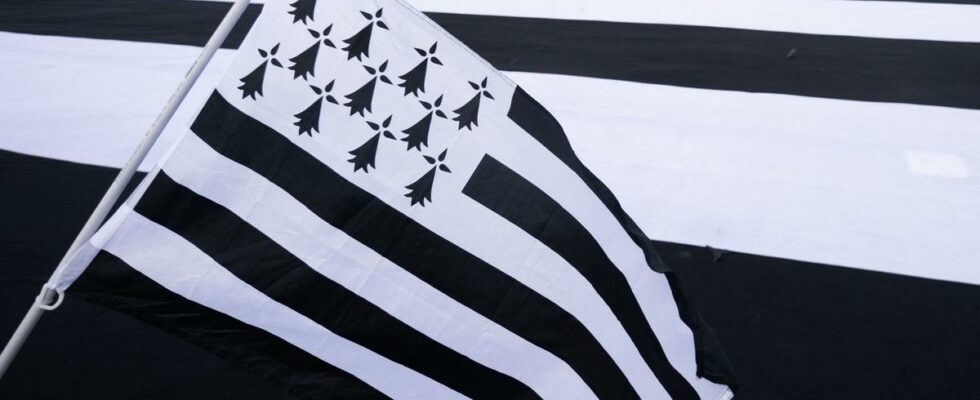In 2020, the flag was hoisted on the pediment of Nantes town hall, a way for the municipality to demonstrate its desire to bring Breton culture and language to life. LOIC VENANCE / AFP
The black and white flag, once associated with regional nationalism, has become a popular symbol of attachment to Breton territory and culture.
Born a hundred years ago from the imagination of a Breton nationalist, the Breton flag, once very ideologically marked, has become over time a unifying and popular emblem of an entire region and a sign of recognition beyond the borders of the peninsula.
In the early 1920s, Brittany emerged bruised from the 1914-1918 war, qualified “of a great bloody rite of passage in the French nation” by Didier Guyvarc’h, author of Popular history of Brittany. For some nationalists, Britain, unlike Ireland, failed to shake off centralism during the Great War. Among this active minority was a young architect, Morvan Marchal (1900-1963), a member of the Breton National Party, who decided to create a new, more modern flag in 1923 (some sources also mention the date of 1925).
Of the old Breton symbols, Marchal keeps only the ermine and the colors. With graphics far removed from heraldry and modeled on the American flag, a symbol of freedom and modernity, the gwenn ha du (“White and Black” in Breton) is composed of stripes symbolizing the nine bishoprics while eleven stylized ermines are found in the upper left corner. “Initially, it was a flag politically and ideologically very linked to Breton nationalism. He absolutely does not represent the Breton population or the province, but an ideological current”recalls Alain Croix, specialist in the history of the region.
SEE ALSO – “French is a language of the future”: In New Orleans, Macron celebrates the Francophonie
Paradoxical rebirth
He only really left these autonomist spheres in 1937 in the pavilion of Brittany at the Universal Exhibition in Paris. Despite this episode, the flag “will take time to become popular: there are effects of the war where there was a compromise of some of the Breton nationalist militants with the German occupier”notes Alain Croix.
We had to wait until after 1968 to see the flag unfurled in demonstrations, including the emblematic one of the French Joint in Saint-Brieuc, or in football stadiums, as after Stade Rennes’ victory in the Coupe de France in 1971. “The real birth of Gwenn ha du occurs more than 40 years after its creation, it’s a bit of a paradox”points out Florian Le Teuff, deputy mayor of Nantes and delegate for Breton issues. “At first restricted to a small circle of political activists (…), it is now established everywhere on the planet, at festivals, in stadiums and campsites, and in all popular circles”notes Florian Le Teuff.
In Nantes but not in Saint-Nazaire
“The number of times in the year I am sent photos of a Gwenn ha du somewhere, in China or in Japan… We see that it is very much used to display its love of Brittany, its pride for the territory», notes Loïg Chesnais-Girard, president (ex-PS) of the region. In Saint-Grégoire, near Rennes, the Mée workshop sold nearly 15,000 Gwenn ha du in 2022 and recently made the largest Breton flag in the world of 1,400 square meters (46 meters by 31), which was deployed in 2022 in the center of Rennes and Nantes. Because if it has lost its sulphurous aspect, the flag can always be the object of political quarrels, sometimes within the same political family, on the background of a question of identity.
Thus, in December 2020, the Gwenn ha du was hoisted on the town hall of Nantes, led by the socialist Johanna Rolland, judging that this banner was “a symbol of our desire to bring Breton culture and language to life”. 60 km further west, in the 2nd city of the department, the municipal council of Saint-Nazaire, also PS, refuses to see the banner floating on the pediment of the town hall after a new vote on the question. in December. “We already have the ermine on the Nazi coat of arms. The Breton identity is already represented, we consider that this Gwenn ha du doesn’t belong here”judge Michel Ray, deputy mayor for culture.
SEE ALSO – “Often, people are scared”: at the Diwan school in Dinan, the 4,000 students follow an immersive learning process in Breton
